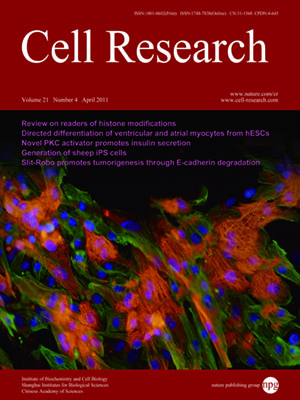
Volume 21, No 4, Apr 2011
ISSN: 1001-0602
EISSN: 1748-7838 2018
impact factor 17.848*
(Clarivate Analytics, 2019)
Volume 21 Issue 4, April 2011: 666-682
ORIGINAL ARTICLES
p53-mediated transcriptional regulation and activation of the actin cytoskeleton regulatory RhoC to LIMK2 signaling pathway promotes cell survival
Daniel R Croft1, Diane Crighton1,2, Michael S Samuel1, Filipe C Lourenco1, June Munro1, Jenifer Wood1, Karim Bensaad1,3, Karen H Vousden1, Owen J Sansom1, Kevin M Ryan1 and Michael F Olson1
1The Beatson Institute for Cancer Research, Garscube Estate, Switchback Road, Glasgow G61 1BD, UK
2Current address: Cancer Research Technology, The Beatson Institute for Cancer Research, Garscube Estate, Switchback Road, Glasgow G61 1BD, UK
3Current address: Weatherall Institute of Molecular Medicine, University of Oxford, John Radcliffe Hospital, Oxford OX3 9DS, UK
Correspondence: Michael F Olson,(m.olson@beatson.gla.ac.uk)
The central arbiter of cell fate in response to DNA damage is p53, which regulates the expression of genes involved in cell cycle arrest, survival and apoptosis. Although many responses initiated by DNA damage have been characterized, the role of actin cytoskeleton regulators is largely unknown. We now show that RhoC and LIM kinase 2 (LIMK2) are direct p53 target genes induced by genotoxic agents. Although RhoC and LIMK2 have well-established roles in actin cytoskeleton regulation, our results indicate that activation of LIMK2 also has a pro-survival function following DNA damage. LIMK inhibition by siRNA-mediated knockdown or selective pharmacological blockade sensitized cells to radio- or chemotherapy, such that treatments that were sub-lethal when administered singly resulted in cell death when combined with LIMK inhibition. Our findings suggest that combining LIMK inhibitors with genotoxic therapies could be more efficacious than single-agent administration, and highlight a novel connection between actin cytoskeleton regulators and DNA damage-induced cell survival mechanisms.
Cell Research (2011) 21:666-682. doi:10.1038/cr.2010.154; published online 16 November 2010
FULL TEXT | PDF
Browse 2204


